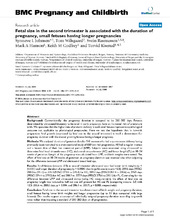| dc.contributor.author | Johnsen, Synnøve Lian | en_US |
| dc.contributor.author | Wilsgaard, Tom | en_US |
| dc.contributor.author | Rasmussen, Svein | en_US |
| dc.contributor.author | Hanson, Mark A. | en_US |
| dc.contributor.author | Godfrey, Keith M. | en_US |
| dc.contributor.author | Kiserud, Torvid | en_US |
| dc.date.accessioned | 2015-01-12T15:12:13Z | |
| dc.date.available | 2015-01-12T15:12:13Z | |
| dc.date.issued | 2008-07-16 | eng |
| dc.identifier.issn | 1471-2393 | |
| dc.identifier.uri | https://hdl.handle.net/1956/9118 | |
| dc.description.abstract | Background: Conventionally, the pregnancy duration is accepted to be 280–282 days. Fetuses determined by ultrasound biometry to be small in early pregnancy, have an increased risk of premature birth. We speculate that the higher rate of preterm delivery in such small fetuses represents a pathological outcome not applicable to physiological pregnancies. Here we test the hypothesis that in low-risk pregnancies fetal growth (expressed by fetal size in the second trimester) is itself a determinant for pregnancy duration with the slower growing fetuses having a longer pregnancy. Methods: We analysed duration of gestation data for 541 women who had a spontaneous delivery having previously been recruited to a cross-sectional study of 650 low-risk pregnancies. All had a regular menses and a known date of their last menstrual period (LMP). Subjects were examined using ultrasound to determine fetal head circumference (HC), abdominal circumference (AC) and femur length (FL) at 10–24 weeks of gestation. Length of the pregnancy was calculated from LMP, and birth weights were noted. The effect of fetal size at 10–24 weeks of gestation on pregnancy duration was assessed also when adjusting for the difference between LMP and ultrasound based fetal age. Results: Small fetuses (z-score -2.5) at second trimester ultrasound scan had lower birth weights (p < 0.0001) and longer duration of pregnancy (p < 0.0001) than large fetuses (z-score +2.5): 289.6 days (95%CI 288.0 to 291.1) vs. 276.1 (95%CI 273.6 to 278.4) for HC, 289.0 days (95%CI 287.4 to 290.6) vs. 276.9 days (95%CI 274.4 to 279.2) for AC and 288.3 vs. 277.9 days (95%CI 275.6 to 280.1) for FL. Controlling for the difference between LMP and ultrasound dating (using HC measurement), the effect of fetal size on pregnancy length was reduced to half but was still present for AC and FL (comparing z-score -2.5 with +2.5, 286.6 vs. 280.2 days, p = 0.004, and 286.0 vs. 280.9, p = 0.008, respectively). Conclusion: Fetal size in the second trimester is a determinant of birth weight and pregnancy duration, small fetuses having lower birth weights and longer pregnancies (up to 13 days compared with large fetuses). Our results support a concept of individually assigned pregnancy duration according to growth rates rather than imposing a standard of 280–282 days on all pregnancies. | en_US |
| dc.language.iso | eng | eng |
| dc.publisher | BioMed Central | eng |
| dc.rights | Attribution CC BY | eng |
| dc.rights.uri | http://creativecommons.org/licenses/by/2.0/ | eng |
| dc.title | Fetal size in the second trimester is associated with the duration of pregnancy, small fetuses having longer pregnancies | en_US |
| dc.type | Peer reviewed | |
| dc.type | Journal article | |
| dc.date.updated | 2013-08-28T17:03:20Z | |
| dc.description.version | publishedVersion | en_US |
| dc.rights.holder | Copyright 2008 Johnsen et al; licensee BioMed Central Ltd. | |
| dc.rights.holder | Synnøve L Johnsen et al.; licensee BioMed Central Ltd. | |
| dc.source.articlenumber | 25 | |
| dc.identifier.doi | https://doi.org/10.1186/1471-2393-8-25 | |
| dc.identifier.cristin | 357938 | |
| dc.source.journal | BMC Pregnancy and Childbirth | |
| dc.source.40 | 8 | |

